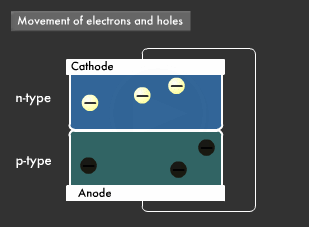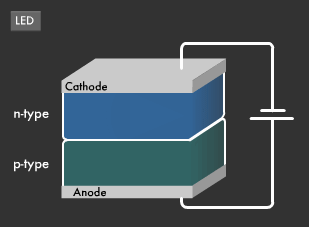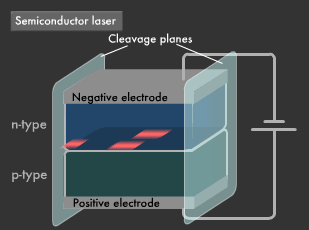Canon Science Lab
LEDs
Light-emitting diodes(LEDs) are artificial lights that can replace incandescent bulbs or florescent tubes. Let's take a look at LEDs that readily found all around us.
LEDs are commonly used in all kinds of applications. The tiny red and green indication lights found here and there on electronic equipment such as TVs and computers are LEDs. They are very efficient in converting an electric current directly into light, but their use was limited by technical constraints preventing the creation of colors other than red and green. In the 1990s, LED color display was made possible by the development of blue LEDs, and we are now witnessing rapid growth in LED applications. The outdoor displays you see on the sides of buildings and other locations on city streets use LEDs. They are also employed in the optical scanning units of color copying machines and image scanners.
Mechanism by Which Light Exposure Produces an Electric Current
To understand LEDs, let's first take a look at the mechanism by which light exposure produces an electric current, such as in solar batteries. Semiconductors, a term you probably hear daily, are a key component of electric circuits, including computers, and they are commonly made from silicon. Semiconductors either use "n-type" silicon, in which there are extra electrons, or "p-type" silicon, in which there are missing electrons that form "electron holes" or simply "holes." Combining these two types of silicon produces a "pn junction diode."

When the pn junction is exposed to light, the p-type silicon becomes an anode and the n-type silicon a cathode. Attaching electrodes to either side and then connecting them to an external electrical conductor produces a current. This is also the principle behind solar batteries.
What do you suppose goes on inside a pn junction diode? When silicon is exposed to light such as that from the sun, electrons and electron holes are produced therein. Connecting the p-type silicon and n-type silicon to an external electrical conductor causes electrons in the electron-rich n-type silicon to move to the p-type silicon and the electron holes in the hole-rich p-type silicon to move to the n-type silicon. This in turn causes the excess electrons to flow out over the electrical conductor from the electrode attached to the n-type silicon and head towards the electrode on the p-type silicon, thereby generating an electric current.

The flow of an electric current is defined as heading in the opposite direction of the flow of electrons, thus we get an electric current in which the p-type silicon is an anode and the n-type silicon a cathode.
Mechanism by Which Application of a Current Produces Light
Since exposing a pn junction diode to light produces an electric current just like a solar battery, the reverse should also hold true, i.e. applying an external electric current in the opposite direction should cause light to emit from the pn junction. This phenomenon does in fact occur. Making the n-type silicon the cathode and the p-type silicon the anode produces light. This is known as a light-emitting diode (LED). However, light emission from such rudimentary LEDs is inefficient, making them ill suited for practical applications. Only after creating pn junctions using semiconductor materials made of the compounds gallium arsenide, gallium phosphide, and gallium arsenide phosphide did LEDs become practical.

Semiconductor Lasers also Use pn Junctions
The semiconductor laser is another technology that uses pn junctions. Creating a pn junction within a semiconductor brings about "population inversion" by means of the electrons that flow into n-type silicon and the electron holes in p-type silicon. By skillfully placing two perpendicular mirrors with cleavage planes of semiconductor crystal on either end of the pn junction, we can intensify light by making it bounce back and forth between the planes, thus producing a laser beam comprising light with uniform phase and direction. Such semiconductor lasers are also called laser diodes.

These devices are only about 300 micrometers square and 80 micrometers thick. Laser diodes using gallium arsenide phosphide, which emit a laser beam with a wavelength of 700 nanometers, are being mass produced for use in compact disc (CD) players and laser beam printers.
